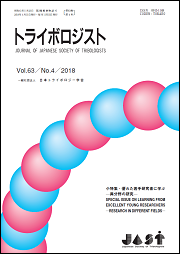Volume 64, Issue 12
Special Issue on Tribology Related to Semiconductor Manufacturing
Displaying 1-16 of 16 articles from this issue
- |<
- <
- 1
- >
- >|
Announcement
-
2019 Volume 64 Issue 12 Pages K12
Published: December 15, 2019
Released on J-STAGE: December 15, 2019
Download PDF (1810K)
Contents
-
2019 Volume 64 Issue 12 Pages M12
Published: December 15, 2019
Released on J-STAGE: December 15, 2019
Download PDF (252K)
Serial Messages to Tribologists
-
2019 Volume 64 Issue 12 Pages 703
Published: December 15, 2019
Released on J-STAGE: December 15, 2019
Download PDF (505K)
Special Issue on Tribology Related to Semiconductor Manufacturing
-
2019 Volume 64 Issue 12 Pages 704
Published: December 15, 2019
Released on J-STAGE: December 15, 2019
Download PDF (191K)
Explanation
-
2019 Volume 64 Issue 12 Pages 705-711
Published: December 15, 2019
Released on J-STAGE: December 15, 2019
Download PDF (2503K) -
2019 Volume 64 Issue 12 Pages 712-717
Published: December 15, 2019
Released on J-STAGE: December 15, 2019
Download PDF (1533K) -
2019 Volume 64 Issue 12 Pages 718-723
Published: December 15, 2019
Released on J-STAGE: December 15, 2019
Download PDF (4853K) -
2019 Volume 64 Issue 12 Pages 724-729
Published: December 15, 2019
Released on J-STAGE: December 15, 2019
Download PDF (1835K)
Up-to-date News Tribo-Episode -Tribo-Technology Award-
-
2019 Volume 64 Issue 12 Pages 730-731
Published: December 15, 2019
Released on J-STAGE: December 15, 2019
Download PDF (3688K) -
2019 Volume 64 Issue 12 Pages 732-735
Published: December 15, 2019
Released on J-STAGE: December 15, 2019
Download PDF (3710K)
Up-to-date News Tribo-Episode -Award for Young Tribologists-
-
2019 Volume 64 Issue 12 Pages 736-737
Published: December 15, 2019
Released on J-STAGE: December 15, 2019
Download PDF (4099K) -
2019 Volume 64 Issue 12 Pages 738-739
Published: December 15, 2019
Released on J-STAGE: December 15, 2019
Download PDF (3548K)
Original Contribution on Science
-
2019 Volume 64 Issue 12 Pages 740-746
Published: December 15, 2019
Released on J-STAGE: December 15, 2019
Advance online publication: October 22, 2019Download PDF (1354K)
Original Contribution on Technology
-
2019 Volume 64 Issue 12 Pages 747-758
Published: December 15, 2019
Released on J-STAGE: December 15, 2019
Advance online publication: October 22, 2019Download PDF (2272K)
Report of the Society
-
2019 Volume 64 Issue 12 Pages 759-765
Published: December 15, 2019
Released on J-STAGE: December 15, 2019
Download PDF (1438K)
Index to Volume 64
-
2019 Volume 64 Issue 12 Pages M-64
Published: December 15, 2019
Released on J-STAGE: December 15, 2019
Download PDF (508K)
- |<
- <
- 1
- >
- >|
